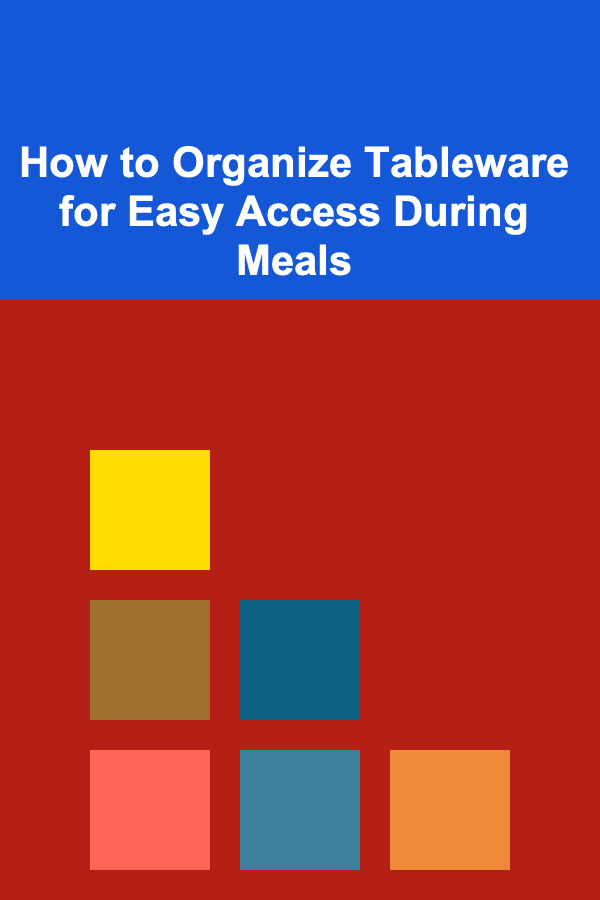
How to Prioritize Tasks on Your Volunteer Work To-Do List
ebook include PDF & Audio bundle (Micro Guide)
$12.99$9.99
Limited Time Offer! Order within the next:

Volunteering is one of the most rewarding ways to contribute to your community, help those in need, and develop new skills. Whether you are volunteering for a charity, a non-profit, or a social cause, there are often many tasks that need attention. From planning events and managing logistics to providing direct assistance and fundraising, the list can seem endless.
The challenge many volunteers face is how to prioritize their tasks effectively. With so much to do, it can be difficult to know where to start and how to manage your time and energy. Prioritizing tasks ensures that the most important and time-sensitive activities are completed first, making the greatest impact and maximizing the efficiency of your volunteer work.
In this article, we will explore how to prioritize tasks on your volunteer work to-do list. We'll cover strategies for assessing tasks, managing your time, balancing short-term and long-term goals, and ensuring that you are working on what truly matters.
Understand the Mission and Core Objectives
Before diving into your to-do list, it's essential to understand the mission and objectives of the organization or cause you are supporting. Having a clear understanding of what the organization stands for and its short- and long-term goals will help you make informed decisions about how to prioritize tasks.
Align Your Tasks with the Organization's Vision
Every task you undertake should align with the broader goals of the organization. For example, if the organization's mission is to improve access to education in underprivileged communities, your focus should be on tasks that directly support that mission. This could include organizing educational workshops, distributing supplies, or managing communication between teachers and students.
Clarify Immediate and Long-Term Objectives
Understand both the immediate needs and the long-term objectives of the organization. Some tasks may be urgent---such as helping with an upcoming event or fundraising campaign---while others may be part of a long-term strategy, like building relationships with donors or creating educational materials.
Categorize and Prioritize Tasks
Once you have a clear understanding of the organization's objectives, it's time to look at the specific tasks on your to-do list. To ensure that you are working on the right things at the right time, categorize the tasks and assess their importance and urgency.
Categorize Your Tasks
Grouping tasks into categories can make it easier to identify what needs to be done. You could consider categories such as:
- Administrative Tasks: These may include answering emails, scheduling meetings, and organizing files. These tasks often serve as the foundation for your work, but they may not always be the most urgent.
- Event Planning: Tasks like booking venues, arranging transportation, and managing guest lists fall under event planning. These tasks may have deadlines but also require significant time and effort.
- Fundraising and Outreach: This category could include tasks like creating fundraising campaigns, contacting potential donors, or organizing community outreach events.
- Direct Service: These tasks involve working directly with the community, such as delivering meals, tutoring children, or providing assistance to individuals in need.
- Communication and Public Relations: Managing social media accounts, writing press releases, or contacting the media fall under communication and PR tasks. These activities are often critical for raising awareness about the organization's work.
Assess the Importance and Urgency
Once your tasks are categorized, prioritize them by assessing both their importance and urgency. One popular method for prioritization is the Eisenhower Matrix, which divides tasks into four quadrants based on urgency and importance:
- Urgent and Important: Tasks that need to be done immediately. These are often time-sensitive and have significant consequences if delayed, such as preparing materials for an event happening the next day or responding to an emergency request from a beneficiary.
- Not Urgent but Important: Tasks that are important but can be scheduled for later, like planning a long-term fundraising strategy or creating educational content for a future campaign.
- Urgent but Not Important: Tasks that are urgent but don't have a significant long-term impact, such as answering routine emails or responding to minor requests. These tasks should be delegated or handled quickly so they don't distract from more important work.
- Not Urgent and Not Important: Tasks that don't require immediate attention and don't have a high impact. These could include organizing volunteer records or updating databases, which are still necessary but can be put off when time is limited.
By focusing on urgent and important tasks first, and addressing the important but non-urgent tasks in the coming days or weeks, you can ensure that your volunteer work is both effective and efficient.
Break Down Larger Tasks into Manageable Chunks
Some volunteer tasks can seem overwhelming, especially if they involve large projects or long-term goals. To avoid feeling overwhelmed, break down complex tasks into smaller, more manageable components. This will not only make the tasks more achievable but also provide a clearer path to success.
For example, if you are tasked with organizing a community fundraiser, break the task down into specific steps, such as:
- Setting the date and location
- Reaching out to potential sponsors and vendors
- Creating promotional materials
- Coordinating volunteers
- Managing ticket sales and donations
- Event day logistics and post-event follow-up
Breaking tasks down into smaller steps also allows you to monitor progress and celebrate milestones along the way, which can be motivating.
Set Realistic Deadlines and Timeframes
Time management is crucial when prioritizing tasks in volunteer work. Setting realistic deadlines and timeframes will ensure that you stay on track and avoid last-minute scrambling.
Factor in Your Availability
Consider how much time you can realistically dedicate to volunteering each week. If you have limited availability, be sure to balance your workload by selecting tasks that are both impactful and manageable. Be transparent with the organization about your time constraints and negotiate deadlines or expectations where necessary.
Allow Buffer Time
When setting deadlines, it's important to factor in buffer time for unexpected delays or challenges. For example, if you are planning an event, allow additional time for unforeseen issues like last-minute cancellations or technical difficulties.
Prioritize Time-Sensitive Deadlines
Some tasks will have firm deadlines that cannot be changed---such as preparing materials for a meeting or a fundraising event. These tasks should be your priority, as they have a direct impact on the organization's ability to achieve its goals.
Delegate and Collaborate
Many volunteer tasks require teamwork. It's important to know when to delegate tasks to others to ensure that the workload is manageable and that tasks are completed efficiently.
Delegate Where Possible
If you are working with other volunteers or team members, don't hesitate to delegate tasks that align with their strengths. For example, if someone has experience in social media management, ask them to handle the organization's social media updates while you focus on other tasks.
Foster Collaboration and Communication
Ensure that there is clear communication among volunteers and team members. Regular check-ins or team meetings can help ensure everyone is on the same page and allow for the sharing of updates, challenges, and resources.
Collaboration fosters a sense of community and ensures that tasks are completed to a high standard, while also preventing burnout.
Stay Flexible and Adjust as Needed
While it's important to prioritize tasks, it's also essential to stay flexible. Volunteer work can be unpredictable, and new tasks or urgent situations may arise unexpectedly. The ability to adjust your priorities as needed is key to being an effective volunteer.
Reassess Priorities Regularly
As new tasks come up or situations change, take a moment to reassess your priorities. You may need to shift your focus to address an urgent issue or adapt to a new strategy. Being flexible will help you stay effective in your role.
Stay Open to New Opportunities
Sometimes, unexpected opportunities arise during volunteer work. Be open to trying new tasks or roles, as these experiences can help you grow and provide additional value to the organization.
Take Care of Yourself
Volunteering can be a fulfilling experience, but it can also be demanding. It's important to take care of yourself so that you can continue to contribute effectively over time.
Set Boundaries
Set clear boundaries around your time and energy. Volunteer work should not take over your personal life, and it's important to avoid burnout. Know when to say no and be mindful of your limits.
Practice Self-Care
Make time for rest, relaxation, and activities that help you recharge. Taking care of yourself physically and mentally will allow you to be a more effective volunteer and maintain a sustainable commitment to your cause.
Conclusion
Prioritizing tasks in volunteer work is essential to making the most of your time and impact. By understanding the organization's mission, categorizing tasks, breaking down larger projects, setting realistic deadlines, and collaborating with others, you can ensure that your volunteer work is both effective and rewarding.
Remember that volunteering is a journey, not a race. By approaching your to-do list with a clear strategy, flexibility, and a focus on self-care, you can contribute to your community in a meaningful and sustainable way.
Reading More From Our Other Websites
- [Personal Care Tips 101] How to Use Hair Serum to Control Frizz and Flyaways
- [Sewing Tip 101] Seasonal Stitching: Fresh Sewing Projects Inspired by Nature's Colors
- [Organization Tip 101] How to Use Digital Tools for Recipe Management
- [Personal Investment 101] How to Create a Long-Term Investment Plan for Financial Freedom
- [Organization Tip 101] How to Organize Your Digital Subscriptions and Accounts
- [Home Renovating 101] How to Do a DIY Home Renovation Like a Pro
- [Home Storage Solution 101] How to Store Shoes Without Taking Up Too Much Space
- [Personal Investment 101] How to Profit from Deep Learning Models in the Freelance World
- [Ziplining Tip 101] Essential Ziplining Gear: A Beginner's Checklist for Safety and Performance
- [Home Maintenance 101] How to Maintain Your Windows and Doors for Energy Efficiency

How to Become a Virtual Cooking Instructor and Make Extra Money
Read More
How to Design a Home Office That Inspires Creativity
Read More
How to Organize Tableware for Easy Access During Meals
Read More
How to Select the Perfect Light Fixtures for Your Home's Ceiling
Read More
How to Use a Corkboard for Important Reminders and Supplies
Read More
10 Tips for Photographing Birds in Flight
Read MoreOther Products

How to Become a Virtual Cooking Instructor and Make Extra Money
Read More
How to Design a Home Office That Inspires Creativity
Read More
How to Organize Tableware for Easy Access During Meals
Read More
How to Select the Perfect Light Fixtures for Your Home's Ceiling
Read More
How to Use a Corkboard for Important Reminders and Supplies
Read More